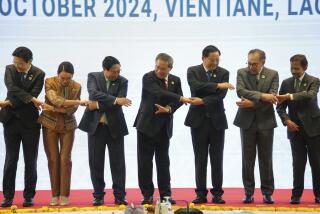New Trade Pact Could Cut Clout of U.S. in Asia
- Share via
China inked a deal with 10 Southeast Asian countries Monday to create the world’s largest free trade area, bolstering its influence in a region long dominated by the United States.
The leaders attending the Assn. of Southeast Asian Nations meeting in Laos also announced plans to hold the first-ever East Asian Summit next year in Malaysia. The Asia-only gathering would include China, Japan and South Korea.
The moves are likely to boost China’s political and economic interests in an area where its relations have been strained by territorial disputes and lingering war animosities.
That could reduce U.S. clout among Southeast Asian nations that are key military allies and large markets for U.S. farm goods, machinery and Hollywood films.
“This is a wake-up call,” said Myron Brilliant, senior vice president of Asia policy for the U.S. Chamber of Commerce. “China is becoming more aggressive in its outreach to its neighbors, and we don’t want to be left behind.”
The free trade pact would lead to the elimination of tariffs by China and ASEAN on thousands of products by 2015.
China’s “charm offensive” -- which includes the development of bilateral trade pacts, increased investment in energy and raw materials producers, and expanded tourism and educational exchanges -- has strengthened its standing as a regional leader at a time when U.S. policymakers have been distracted by the war in Iraq and terrorism, analysts said.
“By any aggregate measure, the United States is still the great power of Asia,” said Kurt Campbell, senior vice president at the Center for Strategic & International Studies in Washington. “But if you go behind the scene in boardrooms, military councils and diplomatic settings, you find that China’s might and influence has grown almost exponentially in the last several years.”
That change was evident during this month’s meeting of the Asia Pacific Economic Cooperation forum in Santiago, Chile. Efforts by Asian business leaders there to push the concept of an Asia-wide free trade zone took a back seat to U.S. concerns over North Korea and Iran.
Nicholas Lardy, a China expert at the Institute for International Economics, said the Bush administration missed a valuable opportunity to use the APEC forum to counter the move toward an Asian-only trade bloc.
“Are we going to have a trade arrangement that draws a line down the middle of the Pacific or are we going to have a trade arrangement that includes the U.S.?” he said. “To the extent we don’t use APEC to promote regional economic integration, by default we’re going to have trade liberalization happening primarily within Asia.”
The renewed interest in East Asian regionalism has been triggered by China’s dramatic economic growth, which has led to a sharp increase in two-way trade with its neighbors. After the 1997 Asian financial crisis, sales of raw materials and components to China helped get its neighbors back on track.
At the same time, China has worked aggressively to increase its diplomatic profile in Asia, offering itself as a middleman in the North Korea nuclear dispute and seeking to defuse territorial disputes in the South China Sea.
With the U.S. preoccupied elsewhere, officials in Beijing have become more involved in setting the regional agenda, from the removal of trade barriers to establishing currency policies.
Li Fan, director of the World and China Institute, a non-government think tank based in Beijing, said the trade pact allows China to boost regional political stability and maintain good neighborly relations.
“North America and the European Union have their economic areas,” he said. “Asia should have one.”
ASEAN officials moved quickly Monday to quash concerns that the group was reviving a controversial plan by former Malaysian leader Mahathir Mohamad for an Asian-only economic group that would challenge U.S. dominance.
At a news conference, ASEAN Secretary General Ong Keng Yong told reporters the East Asian Summit was still at the “brainstorming” stage.
Charles Morrison, president of the East-West Center in Honolulu, described the summit’s creation as a “natural evolution” in Asia’s development that didn’t necessarily threaten U.S. involvement in the region.
“This would be of concern to the United States if it looked as if Asia was uniting against the United States, but this one doesn’t have that flavor,” he said.
Under the trade pact, the six largest members of ASEAN -- Singapore, Indonesia, Malaysia, Brunei, Thailand and the Philippines -- agreed to cut tariffs on 4,000 categories of goods to between zero and 5% by 2010. The four poorest countries -- Laos, Vietnam, Cambodia and Myanmar -- have until 2015. Governments are given leeway to move more slowly in lowering tariffs on their most sensitive products, such as sugar, steel and automobiles.
The implications for U.S. firms are not yet clear, business leaders said.
If the pact leads to increased economic growth, that could benefit U.S. farmers, high-technology companies and others anxious to expand their sales to the region. U.S. multinationals with operations in China would also gain if they could export products to Southeast Asia with lower tariffs.
But if Chinese or Southeast Asian firms are given preferential treatment, particularly in heavily protected sectors such as agriculture or manufacturing, it could put U.S. competitors at a disadvantage, experts said.
Times staff writer Don Lee in Shanghai contributed to this report, and Reuters was used in compiling it.
More to Read
Sign up for Essential California
The most important California stories and recommendations in your inbox every morning.
You may occasionally receive promotional content from the Los Angeles Times.










